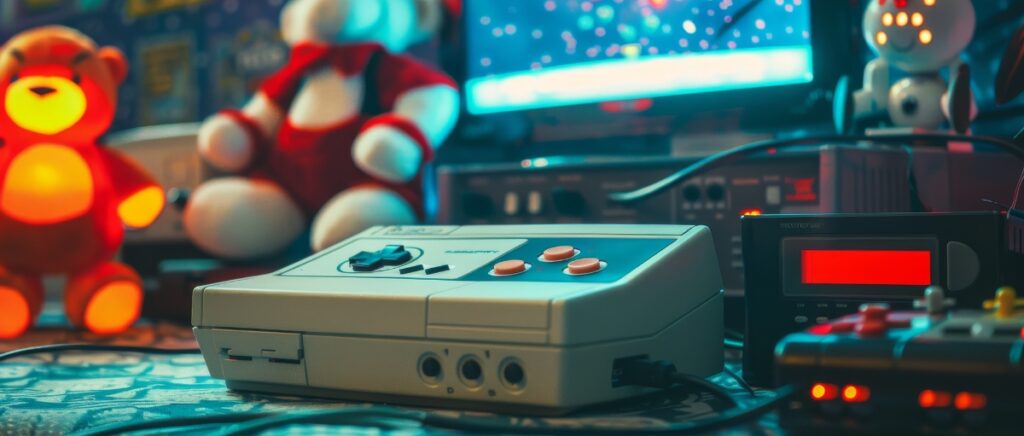Close your eyes and think back to your childhood Saturday mornings. You race to the television, with a bowl of sugary cereal in hand, still in your pajamas. You flip to your favorite channel, just in time to hear a familiar refrain: “Transformers, more than meets the eye!” or “I have the power!”. For kids growing up in the 1980’s, cartoons were more than just entertainment—they were a way of life.
The 80’s were a golden age for animation, with beloved cartoons like He-Man, Transformers, G.I. Joe, and Thundercats captivating millions of young viewers. These shows weren’t just mindless fun; they featured complex storylines, memorable characters, and groundbreaking animation that set the stage for today’s cartoons. Hit shows like Transformers have generated over $480 million in related toy sales.
For the generation that grew up with these cartoon classics, they hold a special nostalgic place in our hearts. Who could forget the excitement of seeing if the Autobots would defeat the Decepticons this week or wondering what new gadget Inspector Gadget would pull out of his hat? The 80s cartoon craze left an indelible mark on pop culture and helped define a generation’s childhood.
We’ll take you on the ultimate nostalgia trip through the most iconic cartoons of the 80’s. We’ll explore the secrets behind their enduring popularity, the memorable characters and catchphrases that still resonate today, and the surprising influence these cartoons had on the entertainment industry.
Get ready to relive your childhood Saturday mornings and discover a newfound appreciation for the cartoons that shaped a decade.
The Best 80’s Cartoons
The 1980s were a golden age for cartoons, filled with vibrant characters and unforgettable storylines.
He-Man and the Masters of the Universe
One of the most beloved cartoons of the 80’s, He-Man and the Masters of the Universe, followed the adventures of Prince Adam, heir to the throne of Eternia. With a raise of his magic sword and the iconic cry of “By the power of Grayskull, I have the power!”, Adam would transform into He-Man, the most powerful man in the universe.
He-Man, along with his allies Man-At-Arms, Teela, and pet tiger Battlecat, defended Eternia from the evil forces of Skeletor. A muscular blue humanoid with a skull for a head, Skeletor was a memorable villain who sought to conquer Castle Grayskull and harness its ancient powers for himself. The colorful assortment of supporting heroes and villains included:
- Sorceress: Guardian of Castle Grayskull who granted Adam his powers
- Evil-Lyn: Powerful witch and Skeletor’s second-in-command
- Beast Man: Skeletor’s savage henchman with control over animals
- Orko: Floating wizard from another dimension who provided comic relief
He-Man and the Masters of the Universe aired 130 episodes from 1983 to 1985. It also inspired a spinoff, She-Ra: Princess of Power, featuring He-Man’s twin sister. The cartoon was produced by Filmation. It was tightly linked to Mattel’s Masters of the Universe toy line, with many characters and vehicles sold to kids.
The show blended science fiction with sword-and-sorcery and delivered strong messages about responsibility and doing the right thing. These themes resonated with children of the 80’s. More than 30 years later, He-Man still stands as a pop culture icon among 80s cartoon characters and lives on in the memories of those who grew up during that era.
G.I. Joe: A Real American Hero
Another quintessential 80’s cartoon, G.I. Joe: A Real American Hero, followed the adventures of an elite U.S. military team in their battles against the evil Cobra organization. The show was based on Hasbro’s G.I. Joe toy line, which underwent a relaunch in the early 80’s with a new scale and characters.
The G.I. Joe team featured a diverse cast of specialists, each with their own unique skills and personalities. Some of the most iconic characters included:
- Duke: The brave and capable field commander of the G.I. Joe team
- Snake Eyes: The team’s mysterious silent ninja
- Scarlett: An expert martial artist and counter-intelligence specialist
- Roadblock: A heavy machine gunner and gourmet chef
On the villainous side, Cobra was led by the ruthless Cobra Commander, with troops that included the master of disguise, Zartan, and the metal-masked Destro, an arms dealer who provided high-tech weapons to the organization.
The G.I. Joe cartoon ran in syndication from 1983 to 1986, comprising 95 episodes. It was well-known for its patriotic theme song which emphatically declared “G.I. Joe is there!” as well as the inclusion of public service announcements at the conclusion of each episode where the characters taught viewers valuable life lessons about things like not talking to strangers or staying away from downed power lines.
The show’s blend of military action and fantasy storylines captivated young audiences. Kids raced to collect the G.I. Joe action figures and vehicles that were prominently featured in each episode. The G.I. Joe craze peaked in 1985 with the relaunch of the toy line, generating over $51 million in the first year and over $100 million in its second year of sales.
Today, G.I. Joe remains one of the most recognizable and fondly remembered cartoons of the 80’s. Its impact on pop culture continues with contemporary comic books, video games, and live-action film adaptations.
Transformers
The Transformers burst onto the animation scene in 1984, introducing a world of sentient alien robots that could transform into vehicles. The Autobots, led by the wise Optimus Prime, were locked in a generations-long battle against the villainous Decepticons, led by the ruthless Megatron.
The show’s premise provided ample opportunities for imaginative sci-fi adventures as the Transformers took their battle to Earth. Kids were enthralled by the ingenious transformations and the distinctive personality quirks of characters like the brash Autobot Hot Rod or the treacherous Decepticon Starscream.
Transformers made history with its 1986 animated movie, set in the then-future year of 2005. The film, featuring celebrity voice talents like Leonard Nimoy and Orson Welles, shocked audiences by depicting the deaths of major characters. The movie became a touchstone for a generation and remains a cult classic.
Thundercats
Thundercats, a Japanese-American co-production, stood out in the 80’s toon landscape with its lush animation and epic fantasy storyline. The series follows the catlike Thunderians, forced to flee their dying homeworld Thundera and resettle on Third Earth.
Led by the young Lord Lion-O and his adviser Jaga, the Thundercats—Panthro, Cheetara, Tygra, and Wilykit & Wilykat—defend their new home and the natives of Third Earth from the ancient evil of Mumm-Ra, an undead sorcerer. Armed with the mystic Sword of Omens, Lion-O repeatedly battles Mumm-Ra and his mutant henchmen.
Thundercats incorporated sophisticated themes like the burdens of leadership alongside stunning set-pieces such as Lion-O’s climactic duel with Mumm-Ra in his final form. The show pushed the boundaries of animated storytelling in the 80’s and is still celebrated for its ambitious world-building.
The Great 80’s Cartoon-Toy Alliance
One can’t discuss 80’s animation without acknowledging the powerful link between cartoons and the toy industry. He-Man, G.I. Joe, and Transformers were all conceived as half-hour commercials to promote their respective toy lines. The strategy clearly worked—Hasbro has generated over $30 million from its Transformers action figures alone.
The cartoon-toy connection was a lucrative two-way street. Cartoons spurred demand for the toys, while the introduction of new action figures and playsets provided fresh plotlines for the shows. It was common for episodes to conspicuously feature a new toy, like the G.I. Joe team acquiring a fancy new vehicle that inevitably ended up on store shelves.
This symbiosis between toy companies and animation studios shaped the entertainment landscape of the decade. The pressure to continually introduce new characters and gadgets to sell toys undoubtedly influenced the narratives of these shows. Yet it also spurred tremendous creativity from the writers and animators who had to devise ever-more ingenious scenarios to showcase the latest playthings.
The Legacy of the 80’s Cartoon Golden Age
Nearly four decades later, the impact of 80s cartoons can still be felt. For those who came of age in the 80s, these shows are cherished childhood memories, a nostalgic link to a simpler time. The continued popularity of 80s cartoon merchandise among adult collectors is a testament to their enduring appeal.
Modern reboots and continuations like Netflix’s She-Ra and the Princesses of Power or the Michael Bay-produced Transformers films have introduced these characters to new generations. While updated for contemporary sensibilities, these revivals still tap into the essential qualities that made the originals so beloved.
80s cartoons also profoundly influenced the animation industry. They proved that action-oriented animated series could be successful, paving the way for groundbreaking shows like The Care Bears, Teenage Mutant Ninja Turtles, The Real Ghostbusters, Dungeons and Dragons, and Chip ‘N Dale: Rescue Rangers. The serialized storytelling and rich world-building of hits like Transformers set a new standard for what could be achieved in a children’s cartoon.
The Timeless Appeal of Cartoons from the 80’s
For children of the 1980s, these cartoons were more than after-school fun. They became cultural touchstones and gave friends something to talk about—like the latest plot twist or the coolest character. They transported kids to fantastical worlds where good triumphed over evil, and anything was possible with the power of imagination.
Today, watching a classic feels like time travel—bringing back the wonder and excitement of being a kid. These shows’ enduring popularity is a testament to the craftsmanship of their creators and the universal appeal of their stories.
As long as there are adults who fondly remember racing to the TV on Saturday mornings, or carefully positioning their G.I. Joe figures for the perfect battle scene, the magic of 80’s cartoons will endure. They are more than just nostalgic relics—they are a celebration of the power of imagination, and a reminder of the eternal child that lives within us all.
Sources
NBC News. (n.d.) Hasbro Transforming How it Sells it’s Toys. Retrieved from https://www.nbcnews.com/id/wbna34229389
IMDb. (n.d.) He-Man and the Masters of the Universe (1983). Retrieved from https://www.imdb.com/title/tt0126158/?ref_=nv_sr_srsg_0_tt_7_nm_1_in_0_q_he%2520man
Toonami Fandom. (n.d.) G.I. Joe: A real American hero. Retrieved from https://toonami.fandom.com/wiki/G.I._Joe:_A_Real_American_Hero
Popular Mechanics. (2019). The history of G.I. Joe. Retrieved from https://www.popularmechanics.com/culture/a25994500/gi-joe-history/
IMDb. (n.d.) The Transformers (1984). Retrieved from https://www.imdb.com/title/tt0086817/?ref_=tt_urv
IMDb. (n.d.) Thundercats (1985). Retrieved from https://www.imdb.com/title/tt0088631/











